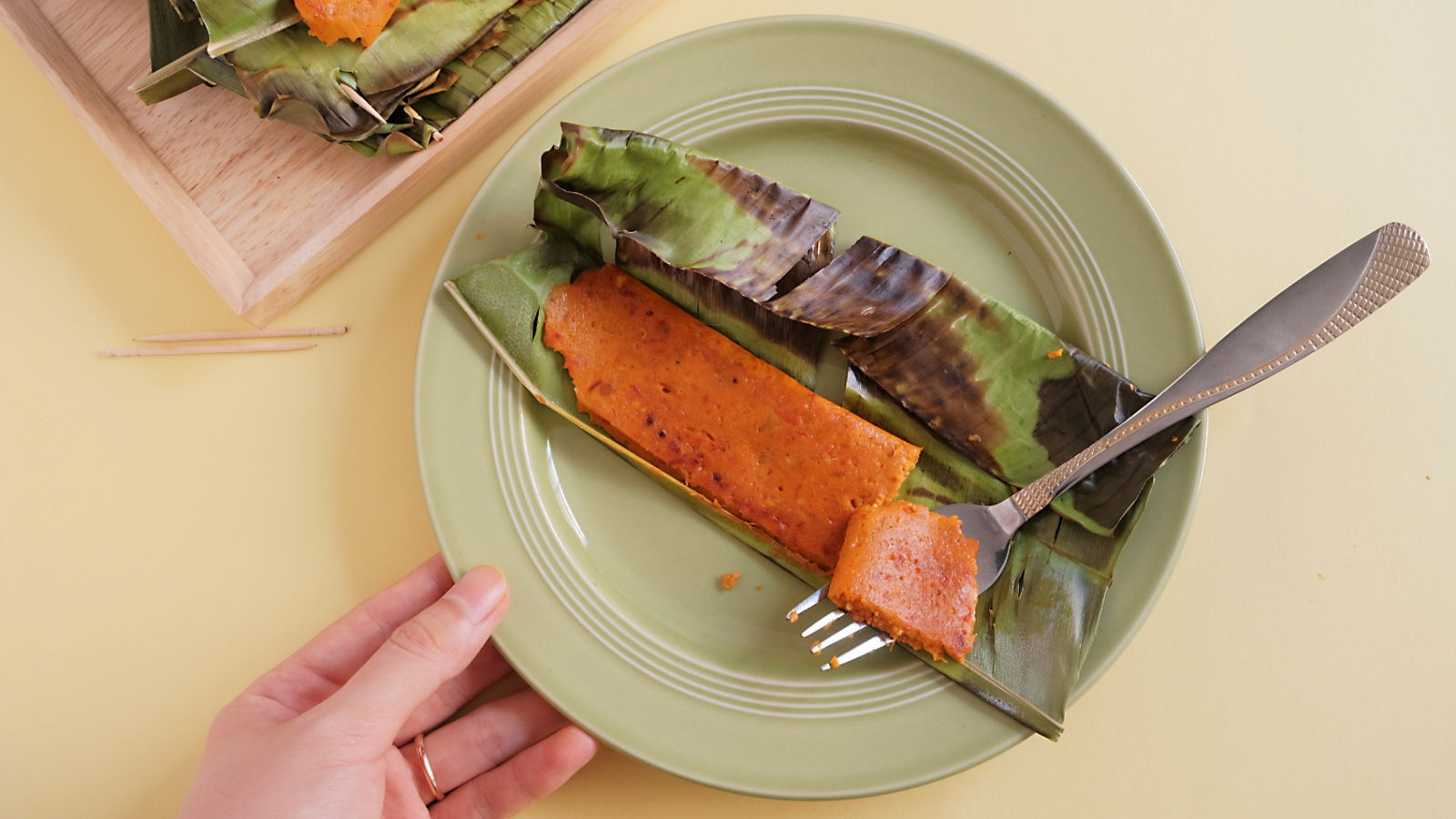In sunny Malaysia, Indonesia or Singapore, otak-otak is a much loved dish by the locals. Once you have tried it, you will fall in love with the taste of this very special fish cake. The fish cake has a good amount of spices and is grilled wrapped in coconut leaf or banana leaf. This gives a natural fragrance to the dish as it cooks. One can smell its aroma miles away when it is being grilled.
Originating from the Malay word ’otak‘ which means brain, the name is based on the soft texture of the dish. Don't let that stop you from trying the dish if you have not done so. Ask any locals, this dish will always be on top of the list when it comes to must-try food around the region. In Indonesia, the fish cake is usually beige in colour as there is no addition of chillies or turmeric unlike those found in Singapore or Malaysia. It is sometimes known as otah too.
Why is this the best otak-otak recipe?
The inspiration to this recipe is the famous otak-otak sold in Muar, a city located in the southern part of Peninsular Malaysia. Besides trying to keep the flavour and texture as similar to it as possible, the the recipe was made easy too. Moreover, making otak-otak is also a fun family activity.
Is otak-otak healthy?
Yes! Besides the fish, all the other ingredients are local herbs and plants. One can either buy them from the wet market or pick them from the herbs garden. These herbs are also known to have health benefits. For example, turmeric is known to be anti-inflammatory and high in anti-oxidants. It is best to make otak-otak with the freshest ingredients possible especially when it comes to fish.
Cooking techniques to perfect the dish
Besides the fresh ingredients, the technique of preparing the dish is equally important. Ensure that the ingredients are blended finely or the final product will have chunks of herbs which will be unpleasant to chew on. Herbs which are harder such as galangal and lemongrass should be blended first before moving onto the softer ingredients.
To ease the blending process, you may add water or more oil to the ingredients. However, adding too much water may cause the blended paste to splatter even more than usual during the cooking process in Step 2.
When it comes to the fish, remove the skin before blending into a finer texture. It is tougher to blend the skin. This is how it should look like after blending all ingredients finely.
It is highly recommended to soak the dried chillies before blending them. This doesn't only help to soften them but also reduce its heat. Follow the step by step guide to softening the chillies here.
If you have a charcoal grill, use it to cook otak-otak. Grilling them over charcoal is exactly how the dish is cooked and sold in food bazaars or night markets. The smokiness and the heat from the charcoal gives a special taste to the dish which gas or electric stove will not be able to replicate.
Types of fish to use
Since fish is the main ingredient, it's important to pick the right type. Spanish mackerel is typically used when it comes to making otak-otak. Fishes such as red snapper, marlin or cod are other types that can be used too.
How to wrap the fish cake?
Otak-otak is traditionally wrapped in attap leaves, which are from the nipa palm tree. You will require two pieces of nipa palm tree leaves that are ca. 15 cm in length. Since attap leaves are naturally folded into halves, spread one piece of the leaf open to fill it with fish paste. Slide the leaf (filled with fish paste) into the other leaf to avoid leakage. Secure both leaves with a tooth pick at both ends.
Banana leaves which are easily available are also used to wrap otak-otak. That is exactly what I used in this recipe. Each piece measures 6 inches x 4 inches. Scoop the fish paste onto the middle of the leaf length wise. Fold the sides to the middle and secure the leaf with toothpicks.
Different ways to cooking
The simplest method of cooking otak-otak is over a stove on a pre-heated pan. However, you may also use the oven. Place them on a pre-heated tray at 200 degrees Celsius for 7 minutes. After that, flip them over and allow to cook for a further 7 to 8 minutes. In all, the cooking time takes around 15 minutes but it might differs depending on the oven used.
Substitute for leaves
If you do not have any attap leaves or banana leaves, parchment paper or baking paper will do then.
Otherwise, you can steam the uncooked otak-otak in a bowl until it is cooked. In fact, steamed otak-otak is regularly served too. The fragrance from the leaves will however not be present.
Freezing otak-otak
The fish paste is best cooked within 24 hours. If not, it should be frozen to contain the freshness of the ingredients. There are two ways to freeze the dish. The fish paste can be frozen in an air-tight container and then thawed to be wrapped in the leaves later.
The other method is to freeze them in a freezer bag after wrapping the fish paste in the leaves. Either way, they should not be frozen for more than 1 month or the flavours will deteriorate.
Ways to reheat
It is a good idea to refrigerate cooked otak-otak if you are not able to finish them in one sitting. You can reheat them by flipping them in a preheated pan over low heat for 3 to 5 minutes. As for frozen otak-otak, reheat them in the same way for at least 5 minutes. However, the duration is highly depending on the thickness of the fish paste.
Heating them in a steamer or in a microwave is also possible.
Dishes to accompany otak-otak
Otak-otak is usually eaten paired with a condiment such as peanut sauce. As a side dish, it is usually eaten with rice. Some nasi lemak stalls do offer otak-otak as a side dish option.

